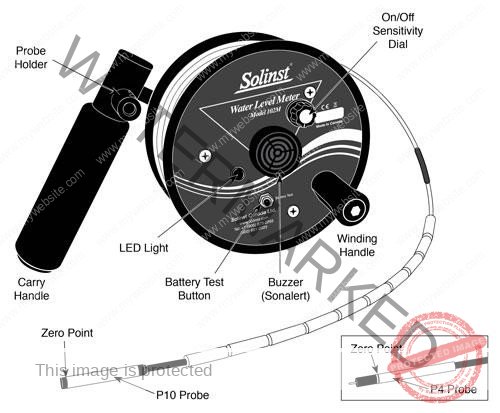Experiment # 9
DRAWDOWN AT OBSERVATION WELLS DURING PUMPING OF A WELL
Object: To observe drawdown at the observation wells using water level indicator during pumping of a well at field.
Apparatus: Pumps fitted with pipes, flowmeter and power-supply, Water-level indicator and Stop-watch.
THEORY: Drawdown is a change in groundwater level/hydraulic head or depth to which groundwater level is reduced / increased from original/static groundwater level, due to an applied stress, caused by events such as:
Pumping from a well
Pumping from a neighboring well
Intensive water taking from local area
Seasonal declines as recharge rates lower
In general, drawdown levels are important and monitored during Pumping tests. A pumping test consists of pumping ground water from a well (main well), usually at a constant rate, and measuring the change in water level (drawdown) in the pumping well and any nearby wells (observation wells, from which no pumping of water is done) or surface water bodies during and after pumping i.e. during recovery period, over a period of time. Time vs. drawdown and recovery data is then used to estimate hydraulic properties of the aquifer.
Pumping tests can last from hours to days or even weeks, depending on the purpose of the pumping test, but traditional pumping tests typically last for 24 to 72 hours.
Based on requirement/purpose, these tests can provide information of or help to determine, water quality and its variability with time, how much groundwater can be extracted from a well based on long-term yield and well efficiency, determine the suitable depth of pump, determine the maximum yield from a well, assess impacts on neighboring wells or water bodies from the proposed use of the well and fundamental aquifer characteristics including hydraulic conductivity, transmissivity, and storability.
- Hydraulic conductivity: A measure of how easily water can move through an aquifer.
- Transmissivity: The rate at which groundwater flows through an aquifer’s entire saturated thickness (or a given unit width).
- Storativity (storage coefficient): The volume of water released from aquifer storage with a decline in hydraulic head (drawdown).



Figure 1. Pumping Methods and Drawdown in the Wells
PROCEDURE:
Bore the wells on the given site, setup pumps, valves, and flow-meter, on main-well, and insert a sounding tube or access tube in all wells, typically a 19 to 25 mm(¾” to 1”) diameter PVC pipe that extends from the top of the casing down to 0.9 to 1.2 m (3 to 4 ft) above the well pump, refer figure.3.
Before Pumping, slowly lower the Probe of the water level indicator using reel in all wells, and measure average static groundwater level, indicated by beep of water-level indicator, by measuring-tape attached to it, with respect to surface of sounding tube, refer figure. 4. The zero point of the tape may be taped at the point representing static water level. This will enable the drawdown to be measured directly rather than by depth to water.
Start constant rate Pumping from the main-well, using pumps, and turn on the stop watch.
At regular intervals, lower the water level indicator in the observation wells and measure the draw-down directly from measure tape attached to it, with respect to sounding tube. The recommended water depth or draw-down depths measurement intervals are:
Pumping Rate (m3/s) | |
Distance of Observation wells (m) | |
Static GW Level (m) |
Time | Drawdown (m) | Time | Drawdown (m) |

Fig.2: Water-Level Indicator




Fig.4: Lowering of Water-level indicator and Measuring Drawdown
Fig.3 Field Pumping Set-up
Results: